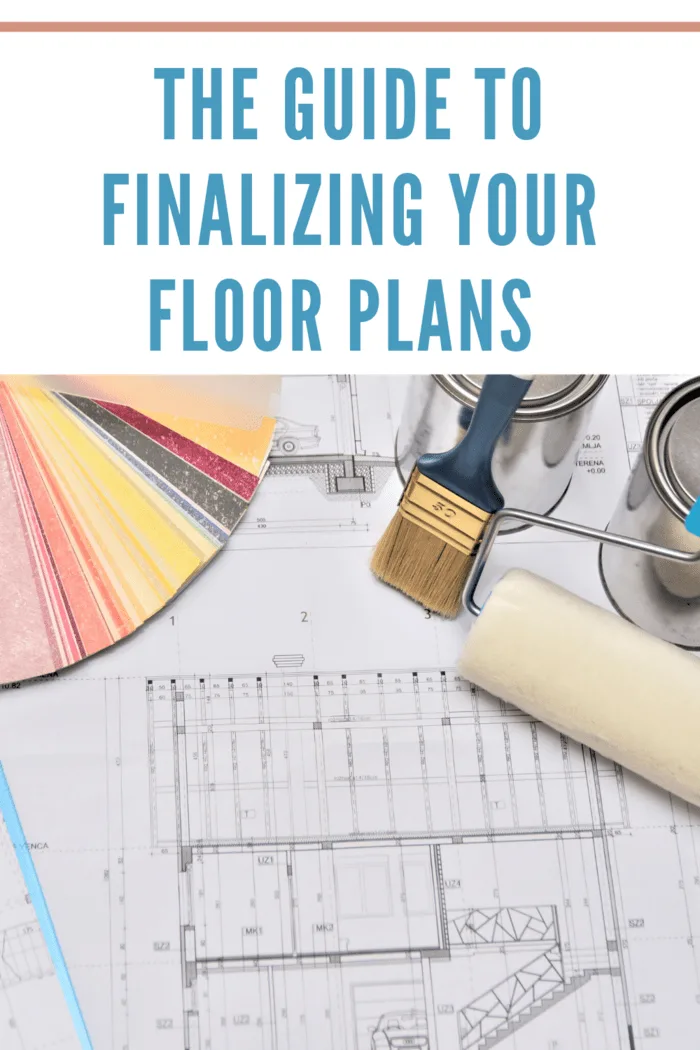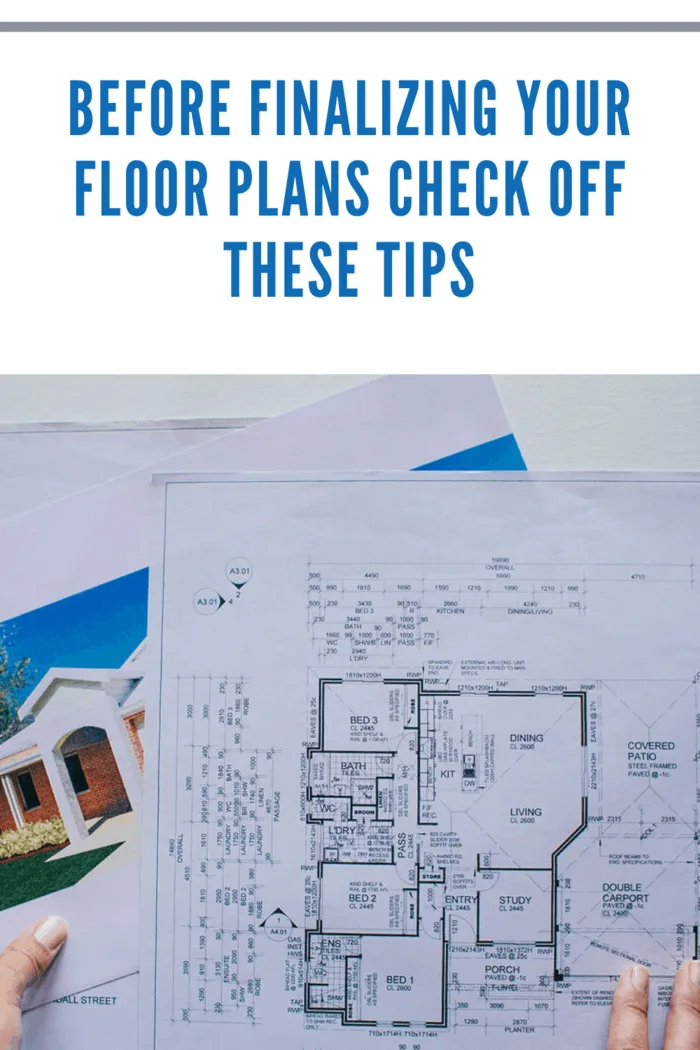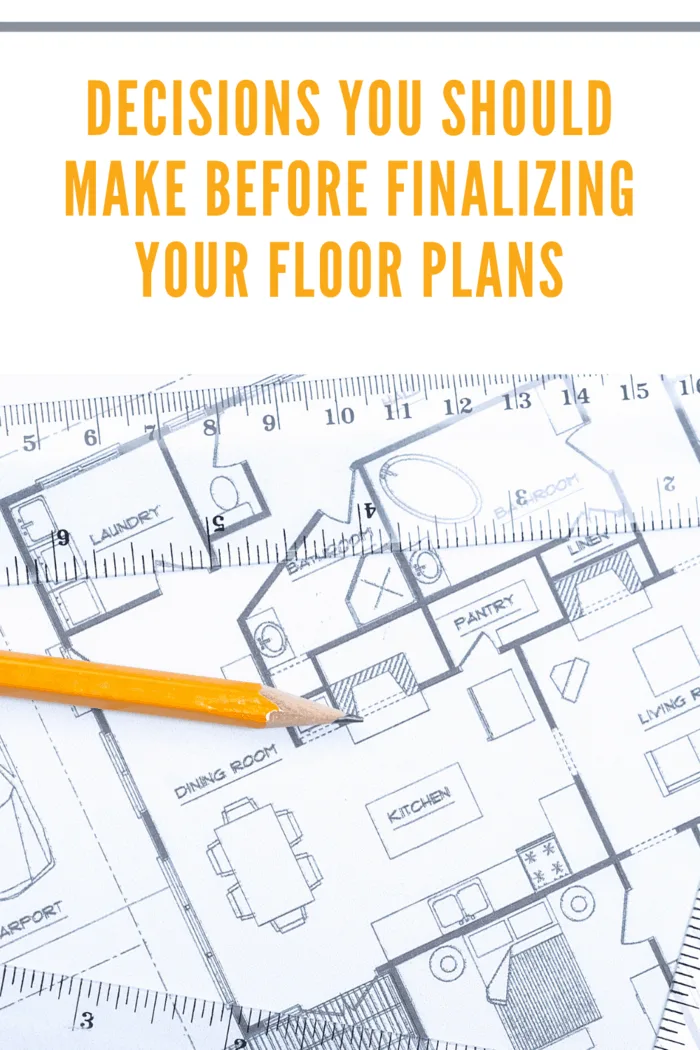When thinking about custom building your home, there is the need to approach this project from the ground up, considering some of the most important factors, such as the floor plans says The Washington Post. Finalizing floor plans for the home is an essential step in the building process, as you cannot attempt construction without knowing what you are trying to construct. When choosing your floor plan, there are several factors you need to consider to ensure that you get the best out of your home. Below are some of the most common decisions you should make before finalizing your floor plans. Find shed plans that you can use to build extra storage and space, says Shed Mechanics.

Decisions You Should Make Before Finalizing Your Floor Plans
Budget
When choosing your floor plan, the first thing to consider is how much you have to invest in the custom home-building project. Just as the custom home builder has to work within the confines of the design plan, which has been drawn, you will also need to work within the confines of your budget. In deciding on the final floor plan for the home, ensure that you prioritize the needed areas, considering the essential areas in the home. As part of the budgeting stage, it is recommended that you should have secured a loan pre-approval as this guarantees that you have a number to work with. Ensure that the custom home builder you will be working with is one that has extensive experience and can offer you high-quality alternatives to improve the chances of building quality without compromising on the budget at hand.
When it comes to finalizing your floor plans, considering your budget is an essential step.
Here’s how the budget comes into play before finalizing floor plans:
- Establishing your budget: Before starting any design work, it’s crucial to determine your budget for the project. Your budget will influence your floor plans, including the size, layout, materials, and finishes you can afford. It helps you set realistic expectations and make informed decisions throughout the design process.
- Identifying your priorities: Knowing your budget enables you to identify your priorities and allocate funds accordingly. You may have specific areas or features of your floor plans that are more important to you than others. For example, you might prioritize a spacious kitchen, a luxurious master suite, or an open-concept living area. By understanding your budget, you can allocate resources to these key areas while making adjustments in less critical areas if needed.
- Cost estimation and feasibility: With a defined budget in mind, you can work with an architect, designer, or contractor to develop preliminary floor plans that align with your financial resources. They can provide cost estimates for various design options, allowing you to assess the feasibility of your ideas. This process helps ensure that your final floor plans are within your budgetary constraints.
- Value engineering: If the initial cost estimates exceed your budget, you can engage in value engineering. This involves reviewing the floor plans and identifying areas where costs can be reduced without sacrificing functionality or aesthetics. It may involve modifying room sizes, adjusting material choices, or exploring alternative construction methods to optimize your budget.
- Material and finish selection: Your budget also influences the selection of materials and finishes for your floor plans. Higher-end materials and premium finishes tend to be more expensive, while more budget-friendly options can still provide a stylish and functional result. By considering your budget during this phase, you can make informed choices that balance cost and quality.
- Long-term financial considerations: Finalizing your floor plans with budget in mind also means considering long-term financial implications. For instance, energy-efficient features, such as insulation, windows, or renewable energy systems, may have higher upfront costs but can lead to long-term savings on utility bills. Evaluating such options can help you make sustainable and cost-effective choices.
In summary, budgeting before finalizing your floor plans allows you to set realistic expectations, prioritize your needs, assess feasibility, make value-driven decisions, and optimize costs without compromising on quality and functionality. It’s an integral part of the design process, ensuring your floor plans align with your financial resources.

Contractor
Once you have settled the budget issue, the next thing is to locate the best contractor to handle your custom home building project. In choosing a custom home building contractor, it is recommended that you conduct due to research into the top building contractors in the area.
Involving a contractor before finalizing your floor plans can be highly beneficial.
Here’s how a contractor comes into consideration during the floor plan finalization process:
- Expertise and experience: Contractors possess valuable expertise and experience in construction and project management. By engaging a contractor early on, you can benefit from their insights and knowledge regarding construction techniques, building codes, material costs, and practical design considerations. They can provide valuable feedback on your floor plans’ feasibility and potential challenges.
- Cost estimation and budgeting: Contractors can provide accurate cost estimates based on your floor plans. They deeply understand construction costs, labor expenses, and material prices. By involving a contractor, you can gain a realistic understanding of the financial implications of your design choices. They can help you identify cost-effective alternatives, suggest value engineering options, and ensure your floor plans align with your budget.
- Constructability and functionality: Contractors can assess the constructability and functionality of your floor plans. They can identify any potential issues or limitations, such as structural considerations, plumbing or electrical challenges, or compliance with building regulations. Their input can help you refine and optimize your floor plans, ensuring they are practical, functional, and can be successfully implemented within your desired timeline and budget.
- Building regulations and permits: Contractors are familiar with local building regulations, zoning restrictions, and permit requirements. By involving them early in the process, you can ensure your floor plans comply with these regulations, avoiding potential delays or costly modifications later on. They can provide guidance on code compliance, necessary permits, and any special considerations for your project.
- Value engineering and design optimization: Contractors can collaborate with architects or designers to perform value engineering. They can review your floor plans and propose cost-saving measures or alternative construction methods without compromising structural integrity or aesthetics. Their practical knowledge can help streamline the design, identify efficiencies, and make recommendations to optimize your floor plans within your budget.
- Construction timeline and sequencing: Contractors can provide insights into your project’s construction timeline and sequencing. They can advise on the order of construction activities, potential dependencies, and critical milestones. By involving a contractor early on, you can gain a realistic understanding of the time required for construction and plan accordingly.
In summary, involving a contractor before finalizing your floor plans brings their construction expertise, cost estimation capabilities, knowledge of regulations, and practical insights into the design process. Their input can help you make informed decisions, optimize costs, ensure constructability, and streamline the overall construction process. Collaborating with a contractor from the outset can contribute to a smoother and more successful floor plan finalization and construction experience.

Size
The size of your home plays a significant role in the floor plan finalization process.
Here’s how the size of your home comes into consideration before finalizing your floor plans:
- Space allocation: The size of your home determines the available space for various rooms and areas. Before finalizing your floor plans, you need to consider how to allocate space efficiently to accommodate your needs and lifestyle. A larger home allows for more flexibility in room sizes and layout options, while a smaller home may require creative space utilization and prioritization of essential areas.
- Room dimensions and functionality: Your home’s size directly impacts each room’s dimensions. Larger rooms provide more flexibility in furniture placement, circulation, and functionality. Smaller homes may require more compact designs, multi-purpose spaces, or creative storage solutions to maximize usability within limited square footage. Considering the size of your home helps ensure that each room is appropriately sized and serves its intended purpose.
- Flow and circulation: The size of your home affects the flow and circulation between rooms. Planning for smooth movement and avoiding cramped or obstructed pathways is essential. In larger homes, you may have the luxury of wider hallways and more open spaces, allowing for a spacious and connected feel. In smaller homes, optimizing traffic flow becomes crucial to maximize functionality and avoid congestion.
- Outdoor spaces and landscaping: The size of your home may influence the design and allocation of outdoor spaces. If you have a larger property, consider incorporating features like a backyard, garden, patio, or pool. The size of your home and available outdoor space will influence the design and integration of these elements into your floor plans.
- Future expansion or scalability: Considering the size of your home before finalizing floor plans allows you to plan for future expansion or scalability if desired. If you anticipate potential growth in your household or have long-term plans for modifications, such as adding extra rooms or extending the living area, factoring in the available space and layout feasibility is essential.
- Energy efficiency and maintenance: The size of your home affects energy consumption and maintenance requirements. A larger home generally requires more energy for heating, cooling, and lighting. It may also involve more significant maintenance responsibilities like cleaning, repairs, and upkeep. Considering the size of your home helps you assess the associated costs and long-term commitments involved.
By considering the size of your home before finalizing your floor plans, you can ensure efficient space utilization, optimal flow, functionality, and scalability. It allows you to design a home that suits your needs, fits within your available space, and supports your desired lifestyle.

Design
Once you have made the decision on the layout of the home, it is time to focus on the design of the custom home. With the design, you can allow your imagination to roam far and wide. Choosing the best design options for your home should entail additions that you wish were in your present abode. An experienced custom home builder may also be able to work with you to choose the best layout and design based on your specific needs. Choosing between an open or closed layout can also significantly influence the overall appearance of the property once completed.
The design of your home is a crucial aspect to consider before finalizing your floor plans.
Here’s how the design of your home comes into consideration:
- Aesthetic preferences: The design of your home reflects your personal taste and style. Before finalizing your floor plans, consider the overall architectural design, such as contemporary, traditional, modern, or a specific theme. This includes exterior features, rooflines, facade materials, and architectural details. Aligning your floor plans with the desired design aesthetic ensures consistency and creates a cohesive and visually pleasing result.
- Functionality and layout: Your home’s design directly influences the floor plans’ functionality and layout. The architectural design determines the placement of walls, structural elements, and load-bearing considerations. It affects the arrangement of rooms, the flow between spaces, and the overall spatial organization. Design choices, such as open-concept layouts, separate living zones, or the integration of specific features, impact the usability and practicality of your floor plans.
- Natural light and views: The design of your home plays a vital role in optimizing natural light and views. Strategic placement of windows, skylights, and glass walls can enhance the daylight entering your home, creating a bright and inviting atmosphere. The design should also consider the home’s orientation about the sun and take advantage of desirable views or outdoor surroundings.
- Energy efficiency and sustainability: The design of your home can incorporate energy-efficient features and sustainable design principles. The design process can integrate insulation, passive solar design, efficient HVAC systems, and renewable energy sources. Considering energy efficiency and sustainability during the design phase helps reduce environmental impact, lower energy costs, and enhance the comfort and livability of your home.
- Flexibility and adaptability: The design of your home should consider flexibility and adaptability to accommodate potential changes in your lifestyle or future needs. It involves designing spaces that can serve multiple purposes, incorporating convertible areas, or planning for potential expansions. A well-designed home considers the evolving needs of its occupants over time.
- Safety and security: The design of your home should prioritize safety and security. This includes considerations such as the placement of entrances and windows for optimal visibility, ensuring sufficient lighting, incorporating security features, and adhering to building codes and regulations. The design should create a sense of comfort and peace of mind.
By considering the design of your home before finalizing your floor plans, you can ensure that your home’s overall look, functionality, and feel align with your preferences and lifestyle. It helps create a harmonious, well-designed space that meets your needs while reflecting your style and values.
Personal Touch
Seeing as you are choosing a custom home, one of the significant advantages you are presented with is the ability to make as many modifications as you wish. You can choose to add extra storage spaces, home automation outlets, USB ports, and more to the home to ensure guaranteed comfort.
Personalization plays a significant role in the process of finalizing your floor plans.
Here’s how personalization comes into consideration:
- Lifestyle and needs: Personalization allows you to tailor your floor plans to fit your specific lifestyle and needs. Consider how you and your family use different spaces in your home. For example, you might prioritize a spacious kitchen and an open-concept living area if you love cooking and entertaining. If you work from home, you may need a dedicated home office space. Identifying these personal requirements helps you design floor plans that cater to your unique lifestyle.
- Room allocation and customization: Personalization allows you to allocate rooms according to your preferences and priorities. You can determine the number of bedrooms, bathrooms, and other functional spaces based on your family size, hobbies, and interests. For example, you might want to include a home gym or exercise area if you enjoy fitness. If you’re an avid reader, a cozy reading nook might be a must-have. Personalizing room allocation ensures that your floor plans meet your specific desires.
- Custom features and amenities: Personalization enables you to incorporate custom features and amenities into your floor plans. This could include a home theater, wine cellar, hobby room, or any other space that aligns with your interests. You can also consider unique architectural elements or design features that reflect your personal taste, such as vaulted ceilings, skylights, or built-in bookshelves. These customizations enhance the character and functionality of your home.
- Material choices and finishes: Personalization extends to selecting materials and finishes that align with your style and preferences. From flooring and cabinetry to countertops and fixtures, you can choose materials that reflect your desired aesthetic, whether it’s modern, rustic, minimalist, or something else. Personalized material choices and finishes add a personal touch and contribute to the overall ambiance of your home.
- Interior design and decor: Personalization also encompasses interior design and decor considerations. You can plan for specific furniture arrangements, color schemes, and decorative elements that resonate with your personal style. This ensures that your floor plans and the subsequent design choices reflect your unique taste and create a space that feels like home.
- Emotional connection and comfort: Personalization allows you to create an emotional connection and a sense of comfort within your home. You can infuse your space with a personal touch by incorporating elements that hold personal meaning, such as family heirlooms, artwork, or sentimental objects. These personalized elements contribute to a welcoming and cozy atmosphere.
By considering personalization before finalizing your floor plans, you can create a home that reflects your individuality, accommodates your specific needs, and provides a sense of comfort and belonging. It allows you to design a space that truly feels like yours.
Final Thoughts:
Making decisions before finalizing your floor plans is important for several reasons:
- Budget management: Considering decisions before finalizing floor plans helps you align the design with your budget. It allows you to make informed choices about room sizes, materials, finishes, and customizations that fit within your financial resources.
- Functionality and efficiency: Making decisions beforehand ensures that your floor plans are functional and efficient. By considering your lifestyle, needs, and priorities, you can allocate space effectively, optimize traffic flow, and incorporate essential features that enhance the usability of your home.
- Aesthetic coherence: Decisions made before finalizing floor plans contribute to the overall aesthetic coherence of your home. By considering architectural styles, design themes, material choices, and finishes, you can create a cohesive and visually pleasing environment that reflects your personal taste and style.
- Feasibility and compliance: Making decisions early on helps assess the feasibility and compliance of your floor plans. Considering building regulations, permits, and structural considerations ensures that your design aligns with legal requirements, safety standards, and practical limitations.
- Personalization and customization: Making decisions before finalizing floor plans allows for personalization and customization. It enables you to incorporate features, amenities, and design elements that cater to your unique lifestyle, preferences, and interests. Personalizing your home creates a space that truly reflects your individuality.
- Time and resource management: Decisions made in advance streamline the design and construction process. By clarifying your choices early on, you can avoid delays, miscommunications, and costly modifications during construction. It allows for efficient project management and effective utilization of time and resources.
Overall, making decisions before finalizing your floor plans is essential to ensure a well-designed, functional, and personalized home that meets your budgetary constraints, aligns with regulations, and creates a space you love and enjoy for years.
